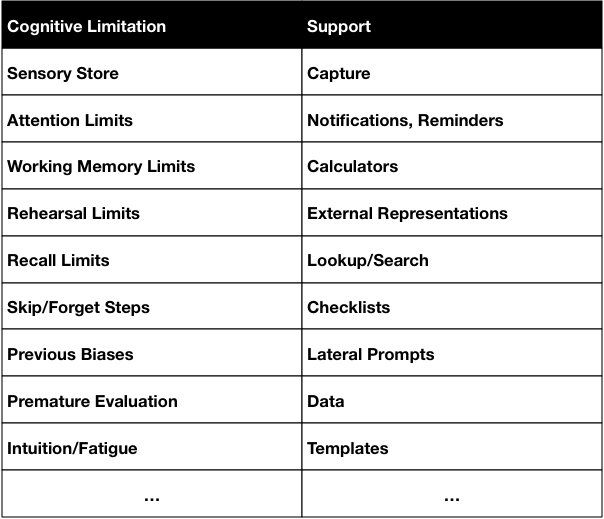One of the ways I’ve been thinking about the role mobile can play in design is thinking about how our brains work, and don’t. It came out of both mobile and the recent cognitive science for learning workshop I gave at the recent DevLearn. This applies more broadly to performance support in general, so I though I’d share where my thinking is going.
To begin with, our cognitive architecture is demonstrably awesome; just look at your surroundings and recognize your clothing, housing, technology, and more are the product of human ingenuity. We have formidable capabilities to predict, plan, and work together to accomplish significant goals. On the flip side, there’s no one all-singing, all-dancing architecture out there (yet) and every such approach also has weak points. Technology, for instance, is bad at pattern-matching and meaning-making, two things we’re really pretty good at. On the flip side, we have some flaws too. So what I’ve done here is to outline the flaws, and how we’ve created tools to get around those limitations. And to me, these are principles for design:
 So, for instance, our senses capture incoming signals in a sensory store. Which has interesting properties that it has almost an unlimited capacity, but for only a very short time. And there is no way all of it can get into our working memory, so what happens is that what we attend to is what we have access to. So we can’t recall what we perceive accurately. However, technology (camera, microphone, sensors) can recall it all perfectly. So making capture capabilities available is a powerful support.
So, for instance, our senses capture incoming signals in a sensory store. Which has interesting properties that it has almost an unlimited capacity, but for only a very short time. And there is no way all of it can get into our working memory, so what happens is that what we attend to is what we have access to. So we can’t recall what we perceive accurately. However, technology (camera, microphone, sensors) can recall it all perfectly. So making capture capabilities available is a powerful support.
Similar, our attention is limited, and so if we’re focused in one place, we may forget or miss something else. However, we can program reminders or notifications that help us recall important events that we don’t want to miss, or draw our attention where needed.
The limits on working memory (you may have heard of the famous 7 ±2, which really is <5) mean we can’t hold too much in our brains at once, such as interim results of complex calculations. However, we can have calculators that can do such processing for us. We also have limited ability to carry information around for the same reasons, but we can create external representations (such as notes or scribbles) that can hold those thoughts for us. Spreadsheets, outlines, and diagramming tools allow us to take our interim thoughts and record them for further processing.
We also have trouble remembering things accurately. Our long term memory tends to remember meaning, not particular details. However, technology can remember arbitrary and abstract information completely. What we need are ways to look up that information, or search for it. Portals and lookup tables trump trying to put that information into our heads.
We also have a tendency to skip steps. We have some randomness in our architecture (a benefit: if we sometimes do it differently, and occasionally that’s better, we have a learning opportunity), but this means that we don’t execute perfectly. However, we can use process supports like checklists. Atul Gawande wrote a fabulous book on the topic that I can recommend.
Other phenomena include that previous experience can bias us in particular directions, but we can put in place supports to provide lateral prompts. We can also prematurely evaluate a solution rather than checking to verify it’s the best. Data can be used to help us be aware. And we can trust our intuition too much and we can wear down, so we don’t always make the best decisions. Templates, for example are a tool that can help us focus on the important elements.
This is just the result of several iterations, and I think more is needed (e.g. about data to prevent premature convergence), but to me it’s an interesting alternate approach to consider where and how we might support people, particularly in situations that are new and as yet untested. So what do you think?
Anytime someone has the brainpower to connect the dots I sit up and take notice. Relating neuroscience to learning (and any tools used in the learning process)is crticial to understanding what works and how to have a successful outcome. Too many people are STUCK in their assumptions and their older, less scientific and more intuitive approach to understanding learning.
So thanks for using the neuroscience research to shine a light on mobile learning, and help me understand the How and Why mobile needs to be done in order to enable the innate learning process. Interesting how the research tells us that the process does not change (after many hundreds of thousands of developmental years), only our understanding of that process, and how to apply learning methodology and tools to enable and not disable it.
Thanks, David. Not really neuro sci so much as cog sci, and not so much learning as performance support, but definitely trying to do the mapping so we can be proactive as well as reactive. Appreciate the thoughts.